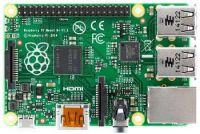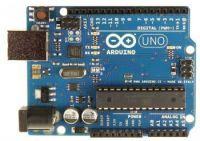
Arduino and Raspberry Pi are the most popular prototype platforms among students, hobbyists and professionals. Experienced electronic engineers know both PCBs and the differences between them, however newbies are often confused and ask questions like:
o which platform to choose for their project,
o which is easier to learn,
o which has more possibilities.
Therefore, in today's article (mainly aimed at newcomers to embedded systems) all the differences between Arduino and Raspberry Pi will be described.
Raspberry Pi
The Raspberry Pi is a fully functional computer consisting of a single printed circuit. It runs on a specially designed Linux-based operating system called Raspbian. It is the official operating system created by the makers of Raspberry Pi, which is used by most users of this platform. In addition, there are also other systems created by third parties, such as: Firefox OS, Android, RISC OS, Ubuntu Mate, as well as the possibility of installing Windows 10 version.
Like any computer, Rpi has its own memory, processor, USB port, audio output, HDMI output and as it is based on Linux, most of the software dedicated to this system is available on it. Raspberry Pi is available in several generations: Raspberry Pi, Raspberry Pi 2, Raspberry Pi 3 (with different models for each generation). These releases differ in parameters of the installed components, but the general idea of operation is the same.
Arduino
Arduino is a development platform based on a simple microcontroller that does not match the computing power of the processor installed on the Raspberry Pi. However, for many simple projects the performance of this processor is more than enough. Unlike the Raspberry Pi, Arduino does not have an operating system, which greatly simplifies the programming process. As in the case of the Raspberry Pi, Arduino also has several variants that differ in the type of microprocessor installed, the mentioned variants are: Arduino UNO, Arduino PRO, Arduino MEGA, Arduino DUE etc.
Differences
In order to understand the differences between the Arduino platform and the Raspberry Pi, the advantages and disadvantages of both devices will be described. First, the advantages of Arduino over Raspberry Pi will be considered:
Advantages of Arduino over Raspberry Pi
Simplicity:
Due to the ease of use, Arduino wins over the Raspberry Pi without a doubt. With a few lines of code and simple software, you can read values from various sensors or buttons, and manipulate various objects, such as fans, motors, heaters, etc. While on the Raspberry Pi, you need to put much more work into the simplest things like reading analog value from a sensor . You need to install libraries and software, you should have knowledge of the structure of the Linux operating system and its commands.
Resilience:
The Raspberry Pi runs on the operating system, so for reliable operation it needs to be shut down properly before turning off the power. Otherwise, the operating system and applications may be damaged. While the Arduino can be turned on and off at any time without the risk of damaging it and when power is restored, it executes the code without a hitch.
Power consumption:
The Raspberry Pi is a powerful device that needs a current of around 500mA and a voltage of 5V. The Arduino, on the other hand, takes about 100mA. The given values may vary depending on the program and configuration of a given platform, but without a doubt Arduino has a much lower power consumption, which can be crucial for battery-powered projects.
Price:
Due to its much simpler construction, the Arduino is much cheaper than its rival. Depending on the model, the price of a Raspberry Pi is roughly double that of an Arduino.
Advantages of Raspberry Pi over Arduino:
After reading all the benefits of Arduino over Rpi, you can start to think that Arduino is the better platform. However, whether a particular tile is better depends mainly on the requirements of the project. Below are the advantages of the Raspberry Pi over the Arduino.
Computing power:
This is the main advantage of the Raspberry Pi. Raspberry is capable of performing tasks in a time comparable to a PC. This feature is especially useful in complex projects involving robotics or websites. Rpi can also be converted to a web server, vpn, database management system, etc. Raspberry Pi is about 40 times faster than Arduino, so you can send e-mails, listen to music, play games, browse the internet. It also has various USB or Ethernet ports and does not require external accessories to perform most of the functions.
Network:
The networking activities on the Raspberry Pi are much easier than its competitor. It has a built-in Ethernet port through which it is possible to connect to the network in a wired manner. You can also connect wirelessly using cheap Wi-Fi modules with a USB interface. In the case of Arduino, you need to purchase external devices that must be properly programmed using a relatively complicated code.
Summary:
Some people find the Arduino platform the best for beginners, however, according to the author, a novice can handle any of them. The choice between platforms should mainly depend on the characteristics of the project.
You should choose Arduino if:
o we have knowledge of electronics or we focus on learning about this field,
o we make a relatively simple project without network functions,
o the structure we create does not require a developed user interface,
o we are not strictly interested in computer issues.
You should choose Raspberry Pi if:
o we deal with a complex project using the network,
o the construction we make requires a complicated user interface, such as VPN or WWW server,
o we are not strictly interested in electronic issues,
o we have good knowledge of Linux.
Arduino is best for repetitive tasks, such as opening doors or turning on lights, and the Raspberry Pi is suitable for more extensive projects, such as a weather station (link to the project) or car multimedia system (link to the project) . Rpi has great potential in the Internet of Things (IoT) world, where devices directly exchange information between them and control multiple elements in the absence of human intervention.
source: https://circuitdigest.com/article/arduino-vs-raspberryp-pi-difference-between-the-two
Cool? Ranking DIY







